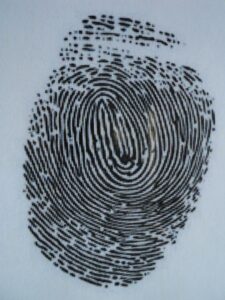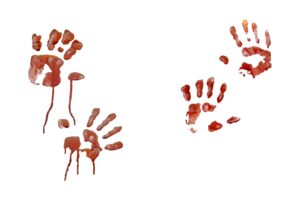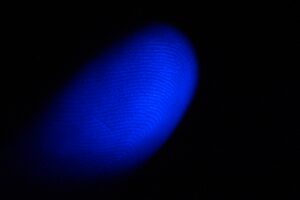By Sue Coletta
 In a recent chat with Jordan, she mentioned that when she went for her TSA pre-check ID for her upcoming trip, they couldn’t detect her digital fingerprints.
In a recent chat with Jordan, she mentioned that when she went for her TSA pre-check ID for her upcoming trip, they couldn’t detect her digital fingerprints.
They said since she spent so much time at a computer keyboard as a writer, she’s deteriorated her ridge detail.
Could this be true of all professional writers?
As you might have guessed, this question sent me down a rabbit hole of research, because I’ve had trouble with my iPhone’s digital fingerprint scan. It only recognizes my thumbprint, not any other finger. Which I figured was just a glitch with the phone. Now, I’m not so sure.
Before we can prove or disprove TSA’s conclusion, we first need to know the basics.
What is a fingerprint?
A fingerprint is a pattern of friction ridge details, comprised of ridges and valleys. A ridge is a high point, a valley is a depression or low point. Friction ridges are also found on our palms, feet, and toes. “Pattern” equals the unique characteristics of the ridges and valleys that make up the print, defined by the spatial relationship of multiple lines, their beginning and terminating points, and the unique pattern they create.
Each ridge contains tiny pores connected to sweat glands beneath the skin. When we touch an object, sweat and oils release from these pores and leave behind a print, latent or visible. The genes from our parents determine the general characteristics of the pattern.

Fun fact: Like human fingerprints, a dog’s nose has a unique identifiable pattern. In fact, many dog clubs now keep nose prints on file.
If you’d like to learn how to print your dog’s nose, see this post. 🙂
Sir Francis Galton was the first person to classify fingerprints into different types based on the three basic features: loops, arches, and whorls. Learn more about points, types, and classifications HERE.
Fingerprints form before birth and remain unchanged until the body decomposes after death.
There are two exceptions to “remain unchanged”…
 If, say, someone sliced the tip of their finger with a knife, it may leave behind a scar. But then, their fingerprint would be even more distinguishable because of that scar.
If, say, someone sliced the tip of their finger with a knife, it may leave behind a scar. But then, their fingerprint would be even more distinguishable because of that scar.
Along similar lines, severe burns can also damage the deep layers of skin and obliterate the ridge detail. However, much like the knife injury, the scars that form would become the injured party’s unique identifiers.
The other exception has to do with the elderly. As we age, we lose skin elasticity, which may affect ridge detail. The fingerprints become wider; the spaces between the ridges narrower. Even though the fingerprint still exists, fingerprint technology may find it more difficult to detect.
Can someone be born without fingerprints?
In a few rare cases, yes. One condition called adermatoglyphia — also known as “immigration delay disease” — can result in a child being born without fingerprints. In some cases, these infants have almost no other health issues. In other cases, this condition could cause skin abnormalities, including tiny white bumps on the face, blistering of the skin, and/or a lack of sweat glands. Adermatoglyphia has only been documented in four families worldwide.
Naegeli Syndrome is another rare condition that halts the production of fingerprints in utero. Said syndrome is characterized by reticular skin pigmentation (meaning, mottled, purplish, and lace-like splotches), diminished function of the sweat glands, and the absence of teeth. Individuals with Naegeli Syndrome have sweat gland abnormalities. Not only do they lack fingerprints but they also suffer from heat intolerance due to a decrease or total inability to sweat.
Do Twins Have the Same Fingerprints?
 No. Twins do not have identical fingerprints. Our prints are as unique as snowflakes. Actually, we have a 1 in 64 billion chance of having the same fingerprints as someone else.
No. Twins do not have identical fingerprints. Our prints are as unique as snowflakes. Actually, we have a 1 in 64 billion chance of having the same fingerprints as someone else.
Sci-fi writers could potentially take advantage of these odds, but it’s such a longshot that it’d be tricky to pull off.
Who’s most at risk for losing their fingerprints?
Patients undergoing chemotherapy — such as capecitabine (Xeloda), for example — are most at risk. With prolonged use of this medication, the finger-pad skin can become inflamed, swollen, and damaged to the point of erasing the ridge detail, according to DP Lyle, MD, author of Forensics for Dummies. Chemotherapy may also cause severe peeling of the palms and soles of the feet. The medical term for this condition is called Hand-Foot Syndrome.
Skin diseases like scleroderma, psoriasis, and eczema also have the potential to obliterate the ridge pattern.
Which professions cause the most damage to fingerprints?
Bricklayers and other heavy manual laborers can wear down their fingerprint ridges to the point where no pattern is visible. Secretaries and file clerks who handle paper all day can have a similar thing occur. Typists (Writers!) and piano players can suffer the same alterations. Hairstylists, dry cleaning workers, and those who work with lime (calcium oxide) are often exposed to chemicals that dissolve the upper layers of the skin, thereby flattening the ridge detail.
So, to answer our initial question, was TSA correct?
Yes! Pounding on the keyboard can wear away a writer’s fingerprints.
How might the lack of fingerprints cause problems?
 Losing one’s prints can cause issues with crossing international borders and even logging on to certain computer systems.
Losing one’s prints can cause issues with crossing international borders and even logging on to certain computer systems.
Fortunately, fingerprint technology is always evolving and improving.
As more and more careers require hours of keyboard time, someday retinal scanners, facial recognition, and voice prints will replace the current technology.
Have you ever been told you have no digital fingerprints? Have you experienced any problems with fingerprint technology?

Maybe that’s why it took numerous tries to get my prints approved at the Global Entry kiosk. My husband said I was just putting my hand too far up the screen.
It wouldn’t surprise me if this was the reason, Terry.
Fascinating stuff, Sue! Thanks for the explanation.
When I applied for TSA pre-check and two other permits that required fingerprints, all three agencies had great difficulty getting digital prints and required many tries. The people in line behind me weren’t too happy, either!
So…does this mean writers don’t have to wear gloves when they break and enter?
Hahahaha. We wouldn’t have to wipe down the murder weapon, either. 😀
Wow. I love all the rabbit holes you researched on this interesting topic, Sue. Of course, a writer would think previously on how this might fit into a story & you’ve presented options. And double “of course” for Doug Lyle to be way ahead of all this. Have a good week & we’ll chat when I get back from my trip. xxoo
Deviously not previously. I hate auto-correct. How can you turn it off? Jeez
Hahaha. Auto-correct is a nightmare! I have no idea how to turn it off, but if you find out, let me know. 😉
You can dissemble author-connect in winter settlings. Oops – I meant you can disable auto-correct in windows settings. (I definitely need it. ?)
Awesome. That’ll work for my laptop. My desktop, however, is a Mac. Sigh.
Thanks, Jordan! I hope you have an amazing time on your trip. Safe travels. <3
I’ve taken a lot of fingerprints and often had trouble getting decent images that were clear enough to read. (This was back in the ink days and before current digital scans.) I can’t say about writers because most of the crooks I printed couldn’t write, but some tradespeople – like bricklayers and masons – had their ridges so worn that they were indistinguishable. Another tough bunch were mechanics because their valleys were so plugged with grease – their prints were just smears.
So, yeah, for sure, many people’s ridges are really worn and that could well happen to writers. I just checked my two typing fingers and see they’re much more worn than the others. Great article, BTW, Sue. You really do your research!
Thanks, Garry!!! Problems with mechanics makes total sense. Hahaha. Your TWO typing fingers? Dude… *facepalm*
That is so interesting! The true crime implications …. and then you can take it a whole new way, right? Like … the writer’s identity has flowed into their books to the point where the writer has none left.
Love it, Kessie! Perfect way to use this info.
My fingerprints are probably still on file with the FBI. I used to be a federal employee, and my they took my fingerprints for my first job. When I switched agencies, they took them again.
Back in the day when a gat was a gun, and gangsters were gangsters and not gangstas. And a thug or gangster went coitins in Brooklyn and curtains everywhere else when he was shot to death by da cops.
Hahahaha. Love this, Jim!
Back in the day when a gat was a gun, and gangsters were gangsters and not gangstas. And a thug or gangster went coitins in Brooklyn and curtains everywhere else when he was shot to death by da cops.
Thanks for the smile. 😀
I am an IT guy. Laptops, door panels, and other bio-metric scanners do not “take fingerprints” in the way a police department does. The scanner creates an image based on your fingerprints. Some people worry that the scanner on the time clock can be accessed by the police and all of the finger prints scanned can then be compared to a crime scene. It can’t.
I don know that some of the older Microsoft scanners could be fooled with “James Bond-ish” fingerprint copies. Also, if your laptop has a finger sized scanner, it would be possible to lift your print with tape. That is why newer laptops have roller type of scanner.
Good to know. Thanks, Alan!
Huh…this explains why a friend of mine couldn’t get into the Global Entry data base. She has been in and out of chemo for years (she’s in remission thank god). But her poor finger tips are always in sad shape. Will have to let her know! Fascinating.
As for me, I breezed thru Global Entry. Wish tells us, perhaps, that I don’t spend enough time at my keyboard. 🙂
So glad to hear your friend is in remission, Kris. Fabulous news!
Hahahaha. Get to work! 😉
Interesting post. I couldn’t help but look at my fingers. I type so much that many of the keys on my two-year-old keyboard have no lettering. Good thing I have the keys memorized. 😉
I can see my fingers are much smoother on the tips than my thumbs.
I’ll have to mention my occupation the next time I’m required to have my fingerprints taken. Being retired, that will probably not happen unless I need a background check for some reason.
Love all the extra trivia in both the post and comments. One can never have enough crime or technical trivia.
I’ve worn out letters on my laptop, too, Cecilia. So it makes sense that we’d wear out our ridge detail.
One can never have enough crime or technical trivia.
So true!
I wear down the letters on my keyboard (a Logitech) in about three months. They’re very good about replacing them when I send pictures. I stick with them simply because they have a wireless combo with programmable buttons on the mouse, which I couldn’t live without after using them for cut, copy, and paste for so many years.
Fascinating information, Sue! I wonder if there’s a way a criminal can fake someone else’s fingerprints.
Funny you should ask that, Kay. I’ve read cases where criminals have planted someone else’s fingerprints at the scene to throw off the forensics. Worked, too, for a little while, anyway.
Pingback: Friday Finds – Staci Troilo
What a coincidence. This is the second time this week I’ve read about disappearing fingerprints. The other was posted in a massage FB Group I follow. It sited that massage therapists wear down their fingerprints over time. So my new pastime of writing my first novel paired with my profession as massage therapist apparently bodes badly for future Global Entry renewals. Good to know.